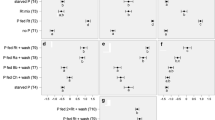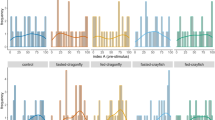Abstract
Effective coordination of behaviors such as foraging and avoiding predators requires an assessment of cues provided by other organisms. Integrating cues from multiple sensory modalities may enhance the assessment. We studied cue integration by tadpoles of Oophaga pumilio, which live in small arboreal water pools. In this species, mothers periodically visit their tadpoles and feed them with unfertilized eggs. When mothers visit, tadpoles beg conspicuously by vibrating until fed. However, animals other than mother frogs including potential predators may visit water pools. Thus, when a visitor appears, tadpoles must use visitor cues to decide whether to beg or to remain inactive to avoid predation. To elucidate the cues that prompt these behaviors, we videotaped behavior of O. pumilio tadpoles in response to isolated and multimodal cues. Tadpoles swam more when exposed to visual or visual and chemical cues of adult O. pumilio but only exhibited begging when exposed to visual, chemical, and tactile cues together. Visual, chemical, and tactile cues from either male or female adult O. pumilio stimulated swimming and begging, but the same cues from similarly sized heterospecific frogs did not. Lastly, tadpoles exposed to a potential predator did not beg and swam less than tadpoles with no stimulus. Together, these findings suggest that O. pumilio tadpoles use multimodal cues to modulate swimming behavior accordingly in the presence of egg provisioners, predators, and other visitors and that tadpole begging is induced by multimodal cues of conspecific frogs such that tactile and perhaps chemical cues supplement visual cues.



Similar content being viewed by others
Explore related subjects
Discover the latest articles and news from researchers in related subjects, suggested using machine learning.References
Azevedo-Ramos C, van Sluys M, Hero JM, Magnusson WE (1992) Influence of tadpole movement on predation by odonate naiads. J Herpetol 26:335–338
Baird TA (1983) Influence of social and predatory stimuli on the air-breathing of the African clawed frog, Xenopus laevis. Copeia 1983:411–420
Barth FG, Cordes D (1998) Cupiennius remedius new species (Araneae, Ctenidae), and a key for the genus. J Arachnol 26:133–141
Barth FG, Seyfarth EA (1979) Cupiennius salei Keys. (Araneae) in the highlands of central Guatemala. J Arachnol 7:255–263
Barth FG, Nakagawa T, Eguchi E (1993) Vision in the ctenid spider Cupiennius salei: spectral range and absolute sensitivity. J Exp Biol 181:63–79
Beletsky LD (1983) Aggressive and pair-bond maintenance songs of female red-winged blackbirds (Agelaius phoeniceus). Z Tierpsychol 62:47–54
Bourne GR, Collins AC, Holder AM, McCarthy CL (2001) Vocal communication and reproductive behavior of the frog Colostethus beebei in Guyana. J Herpetol 35:272–281
Bridges CM (2002) Tadpoles balance foraging and predator avoidance: effects of predation, pond drying, and hunger. J Herpetol 36:627–634
Bro-Jorgensen J (2010) Dynamics of multiple signalling systems: animal communication in a world in flux. Trends Ecol Evol 25:292–300
Brust DG (1993) Maternal brood care by Dendrobates pumilio: a frog that feeds its young. J Herpetol 27:96–98
Caldwell JP, de Araújo MC (1998) Cannibalistic interactions resulting from indiscriminate predatory behavior in tadpoles of poison frogs (Anura: Dendrobatidae). Biotropica 30:92–103
Caldwell JP, deOliveira VRL (1999) Determinants of biparental care in the spotted poison frog, Dendrobates vanzolinii (Anura: Dendrobatidae). Copeia 1999:565–575
Caldwell MS, Johnston GR, McDaniel JG, Warkentin KM (2010) Vibrational signaling in the agonistic interactions of red-eyed treefrogs. Curr Biol 20:1–6
Crawley MJ (2005) Statistics. An introduction using R. Wiley, West Sussex
Crump ML (1996) Parental care among the Amphibia. Adv Stud Behav 25:109–144
DeLuna AG, Hodl W, Amezquita A (2010) Colour, size and movement as visual subcomponents in multimodal communication by the frog Allobates femoralis. Anim Behav 79:739–745
Eklov P (2000) Chemical cues from multiple predator-prey interactions induce changes in behavior and growth of anuran larvae. Oecologia 123:192–199
Feder ME (1983) The relation of air breathing and locomotion to predation on tadpoles, Rana berlandieri, by turtles. Physiol Zool 56:522–531
Gibson RC, Buley KR (2004) Maternal care and obligatory oophagy in Leptodactylus fallax: a new reproductive mode in frogs. Copeia 2004:128–135
Gosner KL (1960) A simplified table for staging anuran embryos and larvae with notes on identification. Herpetologica 16:183–190
Gouchie GM, Roberts LF, Wassersug RJ (2008) The effect of mirrors on African clawed frog (Xenopus laevis) larval growth, development, and behavior. Behav Ecol Sociobiol 62:1821–1829
Graves BM (1999) Diel activity patterns of the sympatric poison dart frogs, Dendrobates auratus and D. pumilio, in Costa Rica. J Herpetol 33:375–381
Haase A, Pröhl H (2002) Female activity patterns and aggressiveness in the strawberry poison frog Dendrobates pumilio (Anura: Dendrobatidae). Amphibia-Reptilia 23:129–140
Heying HE (2001) Social and reproductive behavior in the Madagascan poison frog, Mantella laevigata, with comparisons to the dendrobatids. Anim Behav 61:567–577
Hickman CR, Stone MD, Mathis A (2004) Priority use of chemical over visual cues for detection of predators by graybelly salamanders Eurycea multiplicata griseogaster. Herpetologica 60:203–210
Horat P, Semlitsch RD (1994) Effects of predation risk and hunger on the behaviour of two species of tadpoles. Behav Ecol Sociobiol 34:393–401
Jara FG (2008) Differential vulnerability of Physalaemus pustulosus tadpole size classes to predation by the water spider Thaumasia sp. (Physauridae). Amphibia-Reptilia 29:432–437
Jungfer KH (1996) Reproduction and parental care of the coronated treefrog, Anotheca spinosa (Steindachner, 1864) (Anura: Hylidae). Herpetologica 52:25–32
Jungfer KH, Weygoldt P (1999) Biparental care in the tadpole-feeding Amazonian treefrog Osteocephalus oophagus. Amphibia-Reptilia 20:235–249
Kam YC, Yang HW (2002) Female-offspring communication in a Taiwanese tree frog, Chirixalus eiffingeri (Anura: Rhacophoridae). Anim Behav 64:881–886
Kiesecker JM, Chivers DP, Blaustein AR (1996) The use of chemical cues in predator recognition by western toad tadpoles. Anim Behav 52:1237–1245
Kolliker M, Chuckalovcak JP, Haynes KF, Brodie ED (2006) Maternal food provisioning in relation to condition-dependent offspring odours in burrower bugs (Sehirus cinctus). Proc R Soc Lond B 273:1523–1528
Lannoo MJ, Townsend DS, Wassersug RJ (1987) Larval life in the leaves: arboreal tadpole types, with special attention to the morphology, ecology, and behavior of the oophagous Osteopilus brunneus (Hylidae) larva. Fieldiana Zool 38:1–31
Lawler SP (1989) Behavioural responses to predators and predation risk in four species of larval anurans. Anim Behav 38:1039–1047
Lima SL, Dill LM (1990) Behavioral decisions made under the risk of predation: a review and prospectus. Can J Zool 68:619–640
Magrath RE, Pitcher BJ, Dalziell AH (2007) How to be fed but not eaten: nestling responses to parental food calls and the sound of a predator's footsteps. Anim Behav 74:1117–1129
Manteuffel G, Wess O, Himstedt W (1977) Messungen am dioptrischen Apparat von Amphibienaugen und Berechnung der Sehrschärfe im Wasser und Luft. Zool Jahrb Allg Zool 81:395–406
Maple M (2002) Maternal effects on offspring fitness in Dendrobates pumilio, the strawberry poison frog. Dissertation, University of Kentucky
Mathis A, Vincent F (2000) Differential use of visual and chemical cues in predator recognition and threat-sensitive predator-avoidance responses by larval newts (Notophthalmus viridescens). Can J Zool 78:1646–1652
Mathis U, Schaeffel F, Howland HC (1988) Visual optics in toads (Bufo americanus). J Comp Physiol A 163:201–213
McCollum SA, Leimberger JD (1997) Predator-induced morphological changes in an amphibian: predation by dragonflies affects tadpole shape and color. Oecologia 109:615–621
McDade LA, Hartshorn GS (1994) La Selva Biological Station. In: McDade LA, Bawa KS, Hespenheide HA, Hartshorn GS (eds) La Selva: ecology and natural history of a neotropical rainforest. The University of Chicago Press, Chicago, pp 6–14
Michelsen A, Andersen BB, Storm J, Kirchner WH, Lindauer M (1992) How honeybees perceive communication dances, studied by means of a mechanical model. Behav Ecol Sociobiol 30:143–150
Narins PM, Grabul DS, Soma KK, Gaucher P, Hodl W (2005) Cross-modal integration in a dart-poison frog. Proc Natl Acad Sci U S A 102:2425–2429
Parris MJ, Reese E, Storfer A (2006) Antipredator behavior of chytridiomycosis-infected northern leopard frog (Rana pipiens) tadpoles. Can J Zool 84:58–65
Partan SR, Marler P (2005) Issues in the classification of multimodal communication signals. Am Nat 166:231–245
Petranka JW, Kats LB, Sih A (1987) Predator-prey interaction among fish and larval amphibians: use of chemical cues to detect predatory fish. Anim Behav 35:420–425
Relyea RA (2001) Morphological and behavioral plasticity of larval anurans in response to different predators. Ecology 82:523–540
Rot-Nikcevic I, Denver RJ, Wassersug RJ (2005) The influence of visual and tactile stimulation on growth and metamorphosis in anuran larvae. Funct Ecol 19:1008–1016
Ryan MJ (2001) Anuran communication. Smithsonian Institution Press, Washington
Saporito RA, Donnelly MA, Norton RA, Garraffo HM, Spande TF, Daly JW (2007a) Oribatid mites as a major dietary source for alkaloids in poison frogs. Proc Natl Acad Sci U S A 104:8885–8890
Saporito RA, Zuercher R, Roberts M, Gerow KG, Donnelly MA (2007b) Experimental evidence for aposematism in the dendrobatid poison frog Oophaga pumilio. Copeia 2007:1006–1011
Scheffer SJ, Uetz GW, Stratton GE (1996) Sexual selection, male morphology, and the efficacy of courtship signalling in two wolf spiders (Aranae: Lycosidae). Behav Ecol Sociobiol 38:17–23
Schiesari L, Gordo M, Hodl W (2003) Treeholes as calling, breeding, and developmental sites for the Amazonian canopy frog, Phyrnohyas resinifictrix (Hylidae). Copeia 2003:263–272
Schmid A (1998) Different functions of different eye types in the spider Cupiennius salei. J Exp Biol 201:221–225
Skelly DK (1994) Activity level and the susceptibility of anuran larvae to predation. Anim Behav 47:465–468
Skelly DK (1995) A behavioral trade-off and its consequences for the distribution of Pseudacris treefrog larvae. Ecology 76:150–164
Skelly DK, Werner EE (1990) Behavioral and life-historical responses of larval American toads to an odonate predator. Ecology 71:2313–2322
Smith CL, Evans CS (2008) Multimodal signaling in fowl, Gallus gallus. J Exp Biol 211:2052–2057
Smith GR, Fortune DT (2009) Hatching plasticity of wood frog (Rana sylvatica) eggs in response to mosquitofish (Gambusia affinis) cues. Herpetol Consv Biol 4:43–47
Stauffer HP, Semlitsch RD (1993) Effects of visual, chemical and tactile cues of fish on the behavioural responses of tadpoles. Anim Behav 46:355–364
Stynoski JL (2009) Discrimination of offspring by indirect recognition in an egg-feeding dendrobatid frog. Anim Behav 78:1351–1356
Summers K, Symula R, Clough M, Cronin T (1999) Visual mate choice in poison frogs. Proc R Soc Lond B 266:2141–2145
Uetz GW, Roberts JA (2002) Multisensory cues and multimodal communication in spiders: insights from video/audio playback studies. Brain Behav Evol 59:222–230
van Wijngaarden R, Bolaños F (1992) Parental care in Dendrobates granuliferus (Anura: Dendrobatidae), with a description of the tadpole. J Herpetol 26:102–105
Vonesh JR, Warkentin KM (2006) Opposite shifts in size at metamorphosis in response to larval and metamorph predators. Ecology 87:556–562
Waldman B (1985) Olfactory basis of kin recognition in toad tadpoles. J Comp Physiol A 156:565–577
Waldman B, Bishop PJ (2004) Chemical communication in an archaic anuran amphibian. Behav Ecol 15:88–93
Warkentin KM (2005) How do embryos assess risk? Vibrational cues in predator-induced hatching of red-eyed treefrogs. Anim Behav 70:59–71
Wassersug RJ, Sperry DG (1977) The relationship of locomotion to differential predation on Pseudacris triseriata (Anura: Hylidae). Ecology 58:830–839
Wells KD (2007) The ecology and behavior of amphibians. The University of Chicago Press, Chicago
Werner EE, Anholt BR (1996) Predator-induced behavioral indirect effects: consequences to competitive interactions in anuran larvae. Ecology 77:157–169
Weygoldt P (1980) Complex brood care and reproductive behaviour in captive poison-arrow frogs, Dendrobates pumilio O. Schmidt. Behav Ecol Sociobiol 7:329–332
Wilczynski W, Ryan MJ, Brenowitz EA (1989) The display of the blue-black grassquit: the acoustic advantage of getting high. Ethology 80:218–222
Acknowledgments
We thank SM Whitfield for the statistical aid, R Saporito for the spider identification, D Srivastava and R Tokarz for the comments that improved an earlier version of the manuscript, and AP Brenes and MJ Arguedas for the field assistance. Funding was provided by a fellowship to JLS from the University of Miami.
Ethical standards
The experiments in this study comply with current Costa Rican legislation and were conducted with approval of IACUC of the University of Miami and MINAET of Costa Rica.
Conflict of interest
The authors declare that they have no conflict of interest.
Author information
Authors and Affiliations
Corresponding author
Additional information
Communicated by J. Christensen-Dalsgaard
Rights and permissions
About this article
Cite this article
Stynoski, J.L., Noble, V.R. To beg or to freeze: multimodal sensory integration directs behavior in a tadpole. Behav Ecol Sociobiol 66, 191–199 (2012). https://doi.org/10.1007/s00265-011-1266-3
Received:
Revised:
Accepted:
Published:
Issue Date:
DOI: https://doi.org/10.1007/s00265-011-1266-3




